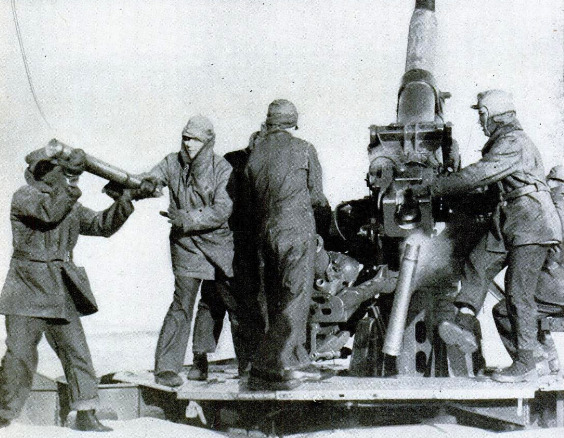-
Title (Dublin Core)
-
Training air defence gunners
-
Article Title and/or Image Caption (Dublin Core)
-
Training air defence gunners
-
extracted text (Extract Text)
-
HIGH-SPEED bombing
planes destroying bridges,
gutting airports, and
wrecking gun emplacements;
low-flying birds of death straf-
ing columns of advancing in-
fantry; huge transport planes
raining parachute troops down
behind defensive lines—these
current indications of the major
role being played by airplanes in
modern warfare make it of para-
mount importance for defend-
ing forces to train ground-based
antiaircraft troops for com-
bating this menace that comes
from the skies.
How is Uncle Sam
training his army to
meet the challenge?
To find out, follow the
men of the 62nd Coast
Artillery as their antiaircraft batteries roll
into Ft. Tilden, N. Y., for a firing-practice
session. Hauled by seven-ton trucks, three-
inch guns capable of hurling twenty-five
fifteen-pound shrapnel shells a minute
thunder in at forty miles an hour, followed
by truck-drawn trailers loaded with fire-
control apparatus, electric generators,
cables, ammunition, range finders, and
the other paraphernalia of antiaircraft war.
Soon the field of fire throbs with
action, as tractors maneuver the
mobile six-ton guns into firing
position, ammunition is unpacked
and cleaned, range finders and
automatic computers are installed
and connected electrically with
the guns and with each other. Of-
ficers equipped with stop watches
get set to time the rate of fire.
Meteorological apparatus is bal-
looned aloft to determine wind
speeds and directions at various altitudes.
Medical Corps men supply cotton for gun-
ners’ ears.
And because this is peacetime action, a
safety officer and his staff prepare to fore-
stall accidents. Previously they have cleared
all shipping and small craft from the waters
over which the guns will fire. Now they
set up a telescope to observe the Army
plane that will tow the thirty-foot “sock”
target on a 3,000-foot cable. No firing will
be allowed until the plane is at a safe angle
away from gun range. When all is in readi-
ness, a red signal flag, hoisted atop a tall
tower, warns that firing is about to begin.
At the long horizontal range-finding in-
strument, trackers peer into telescopic sights
to determine the horizontal and vertical
position of the target in the air. Ata cen-
tral sight, an observer employs his highly
trained gift of three-dimensional vision to
enable the delicate instrument to figure the
range and convert it into altitude.
Cobrdinating and correcting the altitude
and position information furnished by the
range finder is the job of the unit's mechan-
ical brain, an amazing automatic calculator
that computes firing data for the antiair-
craft guns, which are aimed solely by ad-
Justing controls to agree with gun-mounted
instrument dials electrically connected to
the mechanical brain. The gunners never.
even look at their target, for often, at the
moment of firing, the gun muzzle will point
1,000 yards ahead of the target.
Suddenly the air splits with a terrific din
as the guns blast away at the tiny white
target in the sky. Soldiers trained to split-
second timing pass up shells with the pre-
cision of an all-American backfield. Like
clockwork, shells move from ammunition
racks to fuse timers on the guns, where
mechanical hands automatically set the
fuses to burst the shrapnel shells at the
exact altitude of the target, as figured by
the range finder and passed along by the
mechanical brain. Out of the fuse timer
and into the gun breech, shells move at the
rate of one every two seconds.
BUT how is the success of this antiaircraft
practice determined? First, of course,
by examination of the target, but more ac-
curately by the use of two specially de-
signed, synchronized motion-picture cam-
eras. Operating from separated positions,
these cameras are constantly trained on the
target. On each frame of the film in each
camera, figures indicating the exact time
and the exact angular aim of the camera,
are automatically recorded. Thus, when
films are developed, individual frames can
be matched to determine precisely where
the shells burst in relation to the target.
-
Language (Dublin Core)
-
eng
-
Date Issued (Dublin Core)
-
1940-08
-
pages (Bibliographic Ontology)
-
82-85
-
Rights (Dublin Core)
-
Public domain
-
Archived by (Dublin Core)
-
Sami Akbiyik
-
Marco Bortolami (editor)
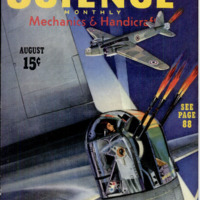 Popular Science Monthly, v. 137, n. 2, 1940
Popular Science Monthly, v. 137, n. 2, 1940
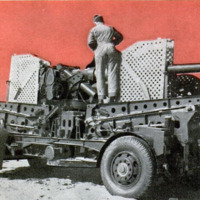 Ekran Resmi 2022-01-31 11.58.53.png
Ekran Resmi 2022-01-31 11.58.53.png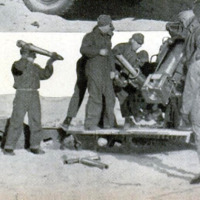 Ekran Resmi 2022-01-31 11.59.04.png
Ekran Resmi 2022-01-31 11.59.04.png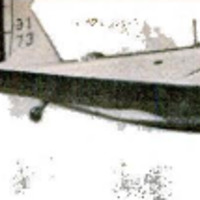 Ekran Resmi 2022-01-31 11.59.11.png
Ekran Resmi 2022-01-31 11.59.11.png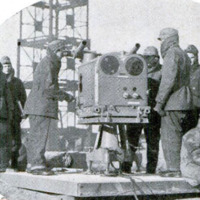 Ekran Resmi 2022-01-31 11.59.20.png
Ekran Resmi 2022-01-31 11.59.20.png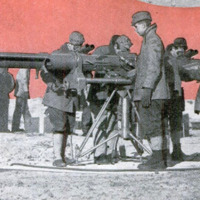 Ekran Resmi 2022-01-31 11.59.31.png
Ekran Resmi 2022-01-31 11.59.31.png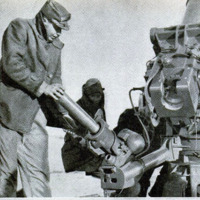 Ekran Resmi 2022-01-31 11.59.42.png
Ekran Resmi 2022-01-31 11.59.42.png Ekran Resmi 2022-01-31 11.59.50.png
Ekran Resmi 2022-01-31 11.59.50.png Ekran Resmi 2022-01-31 12.00.03.png
Ekran Resmi 2022-01-31 12.00.03.png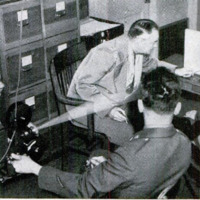 Ekran Resmi 2022-01-31 12.00.08.png
Ekran Resmi 2022-01-31 12.00.08.png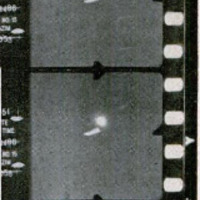 Ekran Resmi 2022-01-31 12.00.15.png
Ekran Resmi 2022-01-31 12.00.15.png






